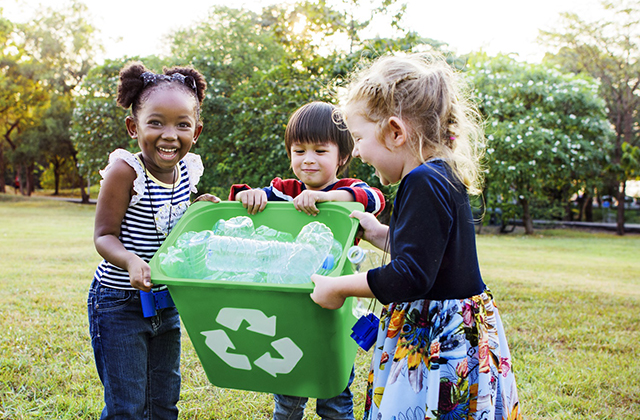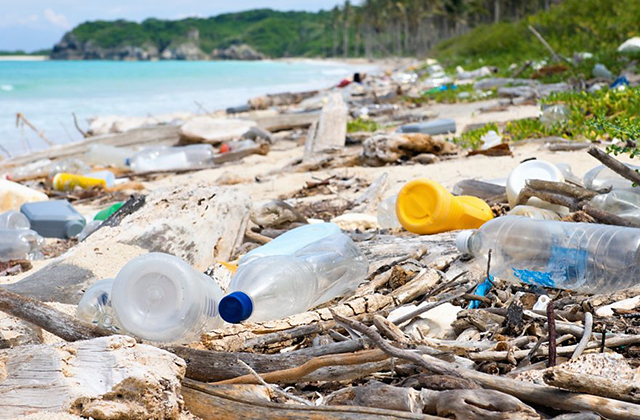
This green waste disposal is easy to dump in a place where it can be use as a fertilizer.
- China’s sudden ban on the importation of recyclable waste threatens household recycling bin collection in Australia.
- The local waste industry is in a mounting crisis and says recycling bin pickup contracts with councils across Australia face default without urgent action by state and federal governments.
- Some bin collection companies have been stockpiling recycled waste, hoping that prices will improve in the future.
The recycling bins of suburban Australia face an uncertain future after almost three decades of training their owners to sort their rubbish into trash and recoverable materials.
China’s sudden decision to stop importing waste material for recycling has turned the economics of recycling markets in Australia — and in other parts of the world — on its head.
Picking up recycling bins is no longer profitable because much of what’s inside them can’t now be sold to China for processing, as the world has done for the past 20 years.
The fallout is enormous and reaches into every home and business in Australia. At risk is a multi billion dollar industry in Australia and the change has triggered crisis talks between waste collection firms and local governments around the country. It also appears likely, at this point, that households may end up having to pay more for their waste collection.
Industry insiders say the costs of picking up the bins is now such a loss-making exercise that some companies may soon simply default on contracts, leading to a real possibility that some towns and suburbs in Australia may cease to have waste collection services.
And it’s all because of an administrative decision by Chinese authorities.
Australia produces about 64 million tonnes of waste, or about 2.7 tonnes for each person, according to government estimates for 2014-15. About 60% of that is recycled in some form.
China’s Ministry of Environmental Protection in July last year filed a notice to the World Trade Organisation advising that recovered mixed paper, textiles, plastics and some metals would be banned from import.
The ban, an extension of China’s Operation Green Fence policy to prohibit the importation of unwashed and contaminated recyclable materials, came into effect in January, barring 24 categories of solid waste, sending already weak prices for recyclable material to rock bottom and making some materials unsaleable and ultimately destined for landfill or for stockpiling.
According to the latest official numbers available, China bought 49.6 million metric tonnes of rubbish in 2015 and the figure is probably much higher because of illegal imports. That year, the US shipped more than 16 million metric tonnes of waste to China.
But last year China created what it called the National Sword program to stop smuggling of foreign waste. China now says this flow of waste has seriously polluted its environment. It wants its industry to deal with its own waste rather than process the world’s.
More than 20% of Australia’s entire annual trade is with China and the impact of a simple policy change will not be lost on other sectors with high exposure to the Chinese market, including mining and agriculture.
Councils across Australia have contracts with waste companies who then move the recycled material to other companies for processing and shipping offshore.
These local government bodies are now faced with contractors who suddenly have to collect recycling bins whose contents are almost worthless and will cost them twice as much to deal with. The collectors want renegotiate their contracts with a higher fee.
Crisis talks
The Municipal Association of Victoria, the body representing local councils, has been in talks with industry every day this week. And the state governments in both Victoria and New South Wales have been holding crisis talks with waste industry and councils.
But it appears inevitable that the recycling companies will need to be paid more, at least in the short term, or they will default on their collection contracts with councils.
Recycling costs, by some estimates, could go to between $80 and $120 a tonne from about $40.
The National Waste and Recycling Industry Council, representing interests of the more than 500 waste management businesses including Cleanaway, JJ Richards, Remondis, ResourceCo, Solo Resource Recovery, Sims Metal Management, Toxfree and Veolia, says recycling contracts across Australia face default without urgent action.
The council says the cancellation of kerbside and commercial recycling contracts would mean the end of the collection and recycling of paper, mixed plastics and some metal products.
“The NWRIC is urging all customers, including local government and commercial waste generators, to meet with their recycling supplier to plan for these sudden and unforeseen changes,” says Phil Richards, Chairman of the NWRIC.
The industry wants a renegotiation of contracts between local governments and recycling providers so that the risks are shares.
They say some stockpiling should be allowed, when safe, and federal government assistance is needed to open new export markets for Australian recyclable material.
In the long term, the reinvigoration of domestic waste recycling capacity is the best long term solution to this challenge, says the industry.
In NSW this week, Tonby Koury, the CEO of the Waste Contractors and Recyclers Association (WCRA), sent an email to members saying he’s seeking urgent intervention by the state government.
“Many of you will by now have heard about the bans by China to reduce the imports of recycled materials,” he wrote.
“For many years, we have relied on China to receive our excess mixed paper, cardboard and various plastic materials (in some cases with contamination rates of up to 15%).”
Khoury attended a meeting convened by the NSW Environment Protection Authority to discuss the recycling crisis.
“On behalf of Members, WCRA made it very clear to the NSW EPA that suitable urgent intervention will be required by the NSW Government,” he says.
He’s now a member of a lead steering committee to work on the likely impacts and short term contingencies needed.
“It is highly likely that recyclers (domestic and commercial) will start to encounter difficulty with the recycling options for dry co-mingled recyclables,” he says.
“In the meantime, please remember the significant investment that we all have in recycling. We cannot afford to get this wrong, nor should we be sending any mixed messages to the community about recycling as we do not want to potentially undermine 28 years of efforts (and success) in promoting the bin with the yellow lid.”
Stockpiling
Some waste collection businesses have been collecting from kerbside bins and then stockpiling recyclable maetrial, hoping that prices will improve.
According to Visy, based in Melbourne and one of the world’s largest privately owned paper, packaging and recycling companies, stockpiling is an environmental hazard and significantly increases the risk of fires.
“Both the above (China) policy change and flooding of alternative markets in Asia, which do not have the substantive processing capacity of China, has resulted in a very significant fall in export returns and in some cases certain materials are now unsaleables,” Visy told a parliamentary inquiry into waste.
“Most operators in the kerbside recycling industry have a heavy reliance on exporting a large portion of the recyclable materials recovered from kerbside collections,” says Visy.
“Export facing commodity sales are exposed to unavoidable volatility and financial risk. For the most part this risk has been borne by recycling operators as Councils have refused to be exposed to any volatility.
“In the case of recovered paper, the volatility leads not only to unreliable revenues from exported volumes, but also volatile input costs to domestic re-manufacturers.”
Hayley Munro-Smith, an industry analyst at IBISworld, says landfills and recycling facilities in Australia will struggle to cope with the additional waste volumes that are no longer destined for China.
“Recycling facilities nationwide will likely approach full capacity, and recyclable waste may need to be sent to landfills alongside disposable waste,” she told Business Insider.
Council rates will probably rise
“Local council rates and landfill levies will likely rise as authorities attempt to recover growing costs and stall the increasing volumes of waste arriving at landfills.
“The Federal Government may arrange to increase volumes of recyclable waste exported to current waste trading partners, such as Malaysia, Thailand, Korea and Vietnam, mitigating some of the effect of the ban.
However, the ban presents a significant opportunity for local firms over the long term.
“Australian recycling companies may expand facilities and build new plants to take on rising quantities of waste,” says Munro-Smith.
“Recycling firms are expected to innovate to develop alternative uses and new markets for recycled materials, funded in part by increasing revenue from recycling processing operations.
“However, with significantly greater supply of recycled products entering the domestic market, the prices for recycled products may stagnate, negatively impacting revenue for Australian recycling firms.”
Gayle Sloan, CEO at the Waste Management Association of Australia, which bills itself as the peak national industry body, says the industry has been telling government for a long time that relying on the export markets for recyclables was dangerous.
“Now we find ourselves, with the change in China’s legislation, walking towards this inevitability,” she says.
“Whilst stockpiling is a legitimate business practice, we know that the community is not happy with simply stockpiling recyclable materials, they rightly want this material to be used in making other products in Australia- reducing reliance on natural material.
“It is not enough that products we purchase in Australia are capable of being recycled, we need to ensure that they are also made from recycled material,” said Ms Sloan, “in this way we can create real demand for commodities like those that households put in their yellow bins.”

